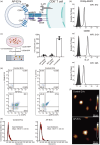Direct delivery of immune modulators to tumour-infiltrating lymphocytes using engineered extracellular vesicles
- PMID: 40154979
- PMCID: PMC11952836
- DOI: 10.1002/jev2.70035
Direct delivery of immune modulators to tumour-infiltrating lymphocytes using engineered extracellular vesicles
Abstract
Extracellular vesicles (EVs) are important mediators of cell-cell communication, including immune regulation. Despite the recent development of several EV-based cancer immunotherapies, their clinical efficacy remains limited. Here, we created antigen-presenting EVs to express peptide-major histocompatibility complex (pMHC) class I, costimulatory molecule and IL-2. This enabled the selective delivery of multiple immune modulators to antigen-specific CD8+ T cells, promoting their expansion in vivo without severe adverse effects. Notably, antigen-presenting EVs accumulated in the tumour microenvironment, increasing IFN-γ+ CD8+ T cell and decreasing exhausted CD8+ T cell numbers, suggesting that antigen-presenting EVs transformed the 'cold' tumour microenvironment into a 'hot' one. Combination therapy with antigen-presenting EVs and anti-PD-1 demonstrated enhanced anticancer immunity against established tumours. We successfully engineered humanized antigen-presenting EVs, which selectively stimulated tumour antigen-specific CD8+ T cells. In conclusion, engineering EVs to co-express multiple immunomodulators represents a promising method for cancer immunotherapy.
Keywords: antigen presentation; cancer immunotherapy; drug delivery; extracellular vesicle; targeted cytokine delivery.
© 2025 The Author(s). Journal of Extracellular Vesicles published by Wiley Periodicals, LLC on behalf of the International Society for Extracellular Vesicles.
Conflict of interest statement
R.H., T.Y., and K.M. applied for a patent (WO2021172595) on antigen‐presenting extracellular vesicles. Other authors confirm that there are no conflicts of interest to declare
Figures







References
-
- Anguille, S. , Van de Velde, A. L. , Smits, E. L. , Van Tendeloo, V. F. , Juliusson, G. , Cools, N. , Nijs, G. , Stein, B. , Lion, E. , Van Driessche, A. , Vandenbosch, I. , Verlinden, A. , Gadisseur, A. P. , Schroyens, W. A. , Muylle, L. , Vermeulen, K. , Maes, M. B. , Deiteren, K. , Malfait, R. , … Berneman, Z. N. (2017). Dendritic cell vaccination as postremission treatment to prevent or delay relapse in acute myeloid leukemia. Blood, 130, 1713–1721. - PMC - PubMed
-
- Atkins, M. B. , Lotze, M. T. , Dutcher, J. P. , Fisher, R. I. , Weiss, G. , Margolin, K. , Abrams, J. , Sznol, M. , Parkinson, D. , Hawkins, M. , Paradise, C. , Kunkel, L. , & Rosenberg, S. A. (1999). High‐dose recombinant interleukin 2 therapy for patients with metastatic melanoma: Analysis of 270 patients treated between 1985 and 1993. Journal of Clinical Oncology, 17(7), 2105–2116. - PubMed
MeSH terms
Substances
Grants and funding
LinkOut - more resources
Full Text Sources
Research Materials

